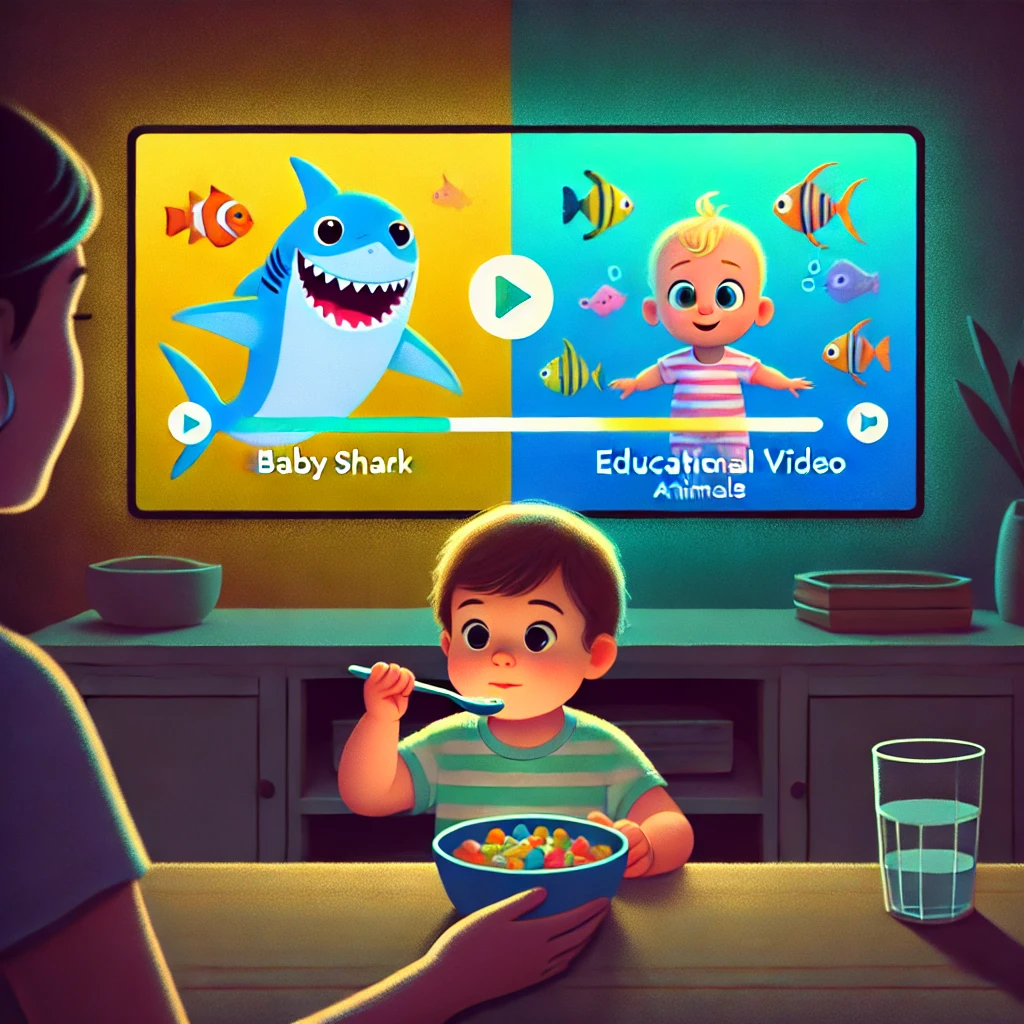
Real Mom Voices: Breaking the Screen-at-Meals Habit
Cold Turkey – A Tough Start, Sweet Finish
Maya’s Story: “One morning, I decided no more tablets at the table. The first two days were brutal – my toddler screamed, refused to eat, and I almost caved. Meal times felt like standoffs, with her crying for cartoons and me doubting myself. But I stayed consistent. By day 3, her protests waned. She nibbled a bit, and I cheered like she’d run a marathon. Each meal after got easier,” Maya recalls. “A week later, we had a new normal: family meals with toys or stories instead of TV. She eats less than with videos, but I’ve learned that’s okay – toddlers won’t starve themselves. Now she actually listens when I talk about her food. Last night she said, ‘Look Mama, broccoli trees!’ I could have cried. It was so worth it.” Maya admits the first days tested her patience and resolve[mumsnet.com] [reddit.com] , but the payoff was a happier, more engaged eater. “We went from dinner-and-a-show to just dinner – and it’s wonderful now,” she says with pride.
Gradual Switch – Learning with SwitchTube
Priya’s Story: “Throwing the iPad out the window wasn’t for us. I needed a gentler off-ramp,” says Priya. She discovered SwitchTube, an app that auto-swaps some of her son’s cartoons with short learning videos[switchtube.io] . “At first I thought, ‘Yeah right, he’ll freak out.’ But surprisingly, when a 30-second alphabet song interrupted Paw Patrol, he watched it! Over a couple weeks, we went from nonstop cartoons to a mix of fun and learning,” Priya explains. The predictable switching actually reduced her toddler’s tantrums over losing the screen[switchtube.io] . “He started repeating new words from the educational clips. I felt less guilty since he was getting something out of it,” she says. Gradually, Priya shortened screen time by setting the app’s timer. “It wasn’t overnight, but each meal I saw him pay more attention to his food – especially when the ‘boring’ educational bits came on!” she laughs. Now her son finishes half his meal before even asking for a video. “SwitchTube was our training wheels. It helped us transition without meltdowns. Some days we still use it for 5 minutes at the start of dinner, but most days we don’t need it at all,” Priya shares. The gradual approach, supported by tools like SwitchTube, created healthier habits with far less drama than Priya feared[heart.org] .

A Hybrid Approach – Finding Middle Ground
Elena’s Story: “Balance was key for us,” says Elena. “Going cold turkey ended in hunger strikes, but letting him have free rein wasn’t good either.” Elena adopted a hybrid strategy. At breakfast and lunch, no screens – instead she gives her 2-year-old small toys or lets him doodle on a notepad. Dinners, when everyone’s most tired, she sometimes permits a short video only until the first course is done. “We set a 10-minute timer or use one song’s length as the limit,” Elena explains. “When the song ends, we pause the video and talk about his day or mine.” Some evenings they skip the video entirely if he’s coping well; other tough days, they use it as a crutch. The key is consistency in routine so he knows what to expect. “He stopped begging for cartoons every meal because he knows he might get a little screen time later,” she notes. Over a month, Elena gradually cut down the duration of dinner screen-time and found her son became less dependent on it. “Now, there are no more meltdowns when we turn it off. We finish eating with him chatting about preschool instead of zoning out,” Elena smiles. Experts note that while completely unplugging works for some families, many kids do better with a gradual reduction and clear limits[heart.org] . Elena’s middle-ground approach kept her sanity intact and still made progress: “We have media-free meals most of the time now, and on the hard days, a few minutes of controlled screen use is our pressure valve,” she says. It’s a reminder that every family’s journey looks different, and that’s okay.
A parent stays calm and offers comfort during a toddler’s meltdown. Even when going “cold turkey” on screens led to tantrums, staying present and patient helped these moms get through the worst of it. Instead of yelling, they held firm with empathy, and their toddlers adjusted in time.
Quick Wins for Exhausted Days: Emergency Tools & Easy Resets
Emergency Calm-Down Scripts for Toddler Meltdowns
When a toddler is in full meltdown or refusing to eat, having a go-to phrase or two can work wonders. Parenting psychologists recommend using short, soothing scripts to validate and comfort rather than yelling[upworthy.com] [hilberpsychsandiego.com] . Here are a few mom-tested, expert-approved phrases for crisis moments:
- “I see you’re struggling.” – A simple acknowledgment that shows your child you understand their feelings. Psychologists call this an anchor phrase that can instantly help a child feel seen and start to calm down
[psychologytoday.com] > . It doesn’t solve the problem on the spot, but it tells your toddler “I get it, you’re upset” – which often diffuses some of the intensity.
- “It’s OK, you don’t have to eat it.” – Use this when your child refuses food or screams “No!” at broccoli. It removes the pressure to eat
[huffpost.com] > . Counterintuitive as it sounds, giving permission not to eat can actually make a stubborn toddler more likely to take a bite once they calm down
[huffpost.com] > . It tells them they’re in control of their body, which reduces the power struggle.
- “Come here, I’ve got you.” – Instead of “Go to your room!” or shouting, try this gentle response

[hilberpsychsandiego.com] > . Open your arms or pull your little one onto your lap. This phrase signals that you’re there to comfort and help them co-regulate their big feelings, not to punish. A firm hug or a hand on their back while saying “I’ve got you” can help their nervous system start to settle
- “Let’s go somewhere quiet for a minute.” – If a tantrum is spiraling (especially in public or at the table), suggest moving to a calmer spot
[hilberpsychsandiego.com] > . In a calm voice: “We’re going to solve this later. Let’s get a drink of water first.” This kind of script removes your child from overstimulation and shows them you’ll help them work through it once they’re calm
[hilberpsychsandiego.com] > . It’s a way of saying “I won’t let this get out of control; I will help you feel safe.”
Each of these phrases is delivered calmly and kindly, even if you’re frustrated. They focus on connection over correction[upworthy.com] [hilberpsychsandiego.com] . By having a few of these “pocket phrases” ready[huffpost.com] [huffpost.com] , you can respond to meltdowns with empathy on autopilot. The more you use them, the more your toddler will trust that you’re on their side – even when you’re enforcing a boundary. These scripts are small but mighty tools to defuse explosive situations and get your little one (and yourself) back to center.

Gentle Fallback Plans for Screen-Time on Tough Days
Sometimes, despite our best efforts, we need a quick screen fix to survive a hard day. The key is to use screens strategically and gently when you’re exhausted, so they serve as a relief without derailing your long-term goals. Here are a few mom-approved fallback plans for those challenging moments when avoiding screens entirely isn’t realistic:
- Opt for Low-Stimulation Content: If you must hand over a screen, choose calming, slow-paced videos instead of fast, loud cartoons. Experts suggest picking shows with gentle visuals, soft sounds, and even pauses for interaction
[bhonestmedia.com] > . For example, shows like “Mister Rogers’ Neighborhood” or “Puffin Rock” have a gentle pace and heartwarming themes that many toddlers find soothing
[parents.com] > . Slower content can keep your child quietly engaged without overstimulating them – almost like a video calm-down corner.
- Use Time-Limits or Specialized Apps: Plan for screens in short, set doses. You can set a timer for, say, 10 minutes of video, or use an app like SwitchTube that automatically limits and intermixes content. SwitchTube, for instance, will alternate fun videos with educational ones at regular intervals, training kids to expect breaks rather than an endless stream
[switchtube.io] > . This way, the screen turns off before a meltdown happens. Built-in tablet timers or parental control apps can serve the same purpose – the device times out, so you don’t have to be the bad guy turning it off.
- Co-View and Engage (If You Can): When possible, watch with your toddler or at least talk about what they’re watching
[healthychildren.org] > . This isn’t always feasible when you desperately need a minute to yourself, but even a little interaction goes a long way. For example, if they’re watching a short clip of “Baby Shark”, you might sing along or clap with them for a moment. The American Academy of Pediatrics notes that kids learn better and stay more regulated when a parent occasionally comments or repeats something from the video
[healthychildren.org] > . Co-viewing turns a passive screen moment into a shared activity and can make it easier to transition away from the screen afterward (“All done – let’s go play with the toy shark we saw in the video!”).
- Save Screens for Specific Scenarios: Establish a “break glass in case of emergency” rule – e.g., screens are only used during the last 10 minutes of dinner or only after your child has tried a bite of each food. This creates a predictable pattern so your toddler knows screens are a sometimes tool, not an anytime crutch. For instance, you might allow a beloved low-key show only on nights when dinner truly falls apart, or only when they’re sick and refusing to eat. By reserving it for special circumstances, you avoid sliding back into the habit for every meal. And when you do use it, you can say, “Remember, this is just for a little while because today was tough. Tomorrow we’ll eat without the iPad again.” Your child hears the message: screens are a limited privilege, not a guarantee.
By using these gentle fallbacks, you give yourself grace on the hardest days without completely reverting to old habits. Think of it as mindful cheating – you’re still in control of how and when the screen is used. And as studies show, even a partial pullback from screen-time has benefits for kids[heart.org] [heart.org] . So a brief, calming video when you truly need it can be the pressure release that keeps your overall progress on track. The next day, you’ll get right back to your routine of books, toys, and family talk at dinner – and that one 10-minute video won’t erase all your hard work.
 ## **Easy, Screen-Free Toddler Meal Ideas**
## **Easy, Screen-Free Toddler Meal Ideas**
One way to avoid needing screens at the table is to serve meals your toddler is happy to focus on. The more engaging and toddler-friendly the food, the less you’ll have to distract them to take bites. Here are some easy-prep, nutritionist-recommended meals that many toddlers love – no screen required:
- DIY Mini Pizzas: Turn dinner into a fun activity. Use small pita bread or English muffins as crusts and lay out toppings (cheese, tiny pepperoni, veggies). Let your toddler “decorate” their own pizza. Why it works: Kids are more likely to eat food they helped make
[huckleberrycare.com] > . This hands-on meal engages their curiosity and fine motor skills. Plus, you can sneak on veggies – a few bell pepper or olive pieces – as decorations. When the mini pizza comes out of the oven, they’ll be excited to taste their creation.
- Build-Your-Own Taco Bar: Set up a toddler-friendly taco station with small bowls of ingredients: soft tortilla pieces, cooked meat or beans, shredded cheese, avocado chunks, etc. Your child can pick what they want in their taco (or eat each item separately – that’s okay too!). Why it works: Offering a variety of foods lets toddlers graze and sample at their own pace
[huckleberrycare.com] > . Tacos also naturally include multiple food groups, so even if they only eat the tortilla and some cheese, they’re still getting a balanced bite
[huckleberrycare.com] > . This meal is colorful, interactive, and adaptable to picky preferences.
- One-Pan Sheet Roast: Roast an assortment of finger foods on a baking sheet and dinner is done. For example, chicken pieces or tofu, sweet potato chunks, broccoli florets – all drizzled with a little olive oil and seasonings, baked until soft. Why it works: Everything comes out tender enough for toddlers to handle, and you can serve it deconstructed (meat separate from veggies) which many kids prefer
[huckleberrycare.com] > . The variety on the tray gives them options to choose from, and roasting brings out the natural sweetness in veggies. It’s super easy for parents (minimal cleanup!) and lets toddlers explore different flavors and textures at their own pace.
- Veggie-Boosted Pasta: Take a toddler staple – pasta – and add a healthy twist. Macaroni or rotini tossed with a favorite sauce and finely chopped vegetables (think spinach ribbons, diced zucchini, peas, etc.). You can even use fun-shaped pasta to up the interest factor. Why it works: Most toddlers will happily slurp noodles, and the veggies stick to the pasta, sneaking into each bite
[huckleberrycare.com] > . The meal is familiar yet nutritious. You can change up the sauce (tomato, cheese, pesto) and veggies each time to expose your child to new tastes without overwhelming them. It’s quick, customizable, and usually met with an empty plate.
These meal ideas come from pediatric dietitians and feeding therapists who know that engagement is half the battle at mealtime[huckleberrycare.com] . By making the food itself interesting – through color, shape, build-it elements, or kid involvement – you’re naturally drawing your toddler’s attention to their plate instead of a screen. And an engaged toddler is a toddler who eats! Remember to keep offering new foods alongside well-loved favorites, and don’t be discouraged by fickle appetites. As the experts remind us, it’s normal for toddlers’ intakes to vary day to day[huckleberrycare.com] . The goal is to create a positive, stress-free mealtime environment. With these easy, screen-free meals and the strategies above, you’re building healthy habits that will serve your child for life – one bite (and one day) at a time.


